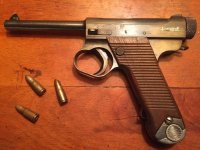I made some Arisaka cases from 30-06 cases that I have plenty of. The books say the case length is 2.070". By the time I trimmed and deburred them they measured about 2.68" which I think is ok. (a little room to grow).
But one case came out short and another a little long. I'm not worried about the long one because I can trim it a little more but I'm afraid the short one is TOO short by about 1/10". I don't know how this anomaly happened but I made some extras just in case something messed up.
So, I looked through my books, wikipedia, SAAMI specs and a few other places and I can't find the minimum and maximum case length for the Arisaka round. Can anybody help me with this?
Thanks in advance...
PS: I looked all up and down the rifle section of the SAAMI specs and didn't see the 7.7. Did I miss it or is there some reason that it's not included?
PPS: Oh, neat trick. I trimmed some case with an abrasive wheel, which cut like butter but was hard to control and see exactly what it was doing. (I'll bet that's how I got the short case) I got a mini-tubing cutter and when you put it on the neck of the pushed down 30-06 case, you can cut it off just about right. I tried to see if a regular size tubing cutter would do it but it was too wide.
But one case came out short and another a little long. I'm not worried about the long one because I can trim it a little more but I'm afraid the short one is TOO short by about 1/10". I don't know how this anomaly happened but I made some extras just in case something messed up.
So, I looked through my books, wikipedia, SAAMI specs and a few other places and I can't find the minimum and maximum case length for the Arisaka round. Can anybody help me with this?
Thanks in advance...
PS: I looked all up and down the rifle section of the SAAMI specs and didn't see the 7.7. Did I miss it or is there some reason that it's not included?
PPS: Oh, neat trick. I trimmed some case with an abrasive wheel, which cut like butter but was hard to control and see exactly what it was doing. (I'll bet that's how I got the short case) I got a mini-tubing cutter and when you put it on the neck of the pushed down 30-06 case, you can cut it off just about right. I tried to see if a regular size tubing cutter would do it but it was too wide.
Last edited:


